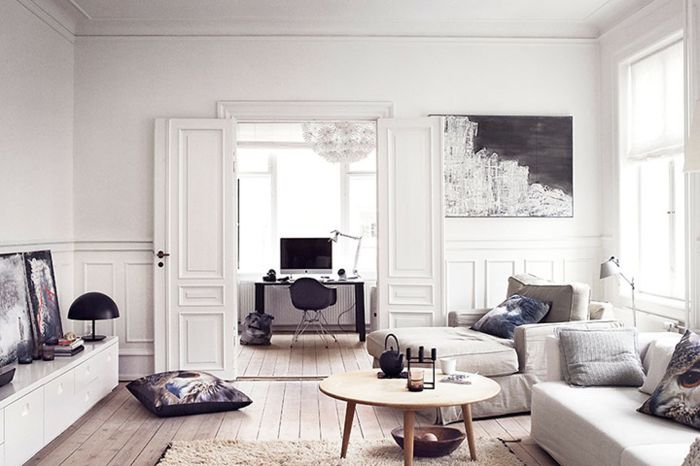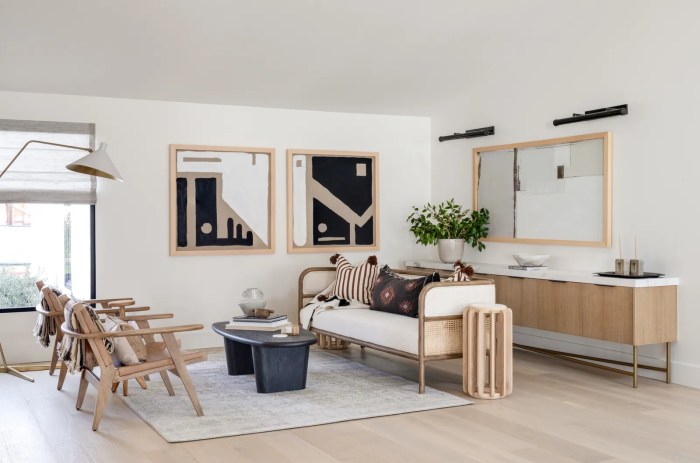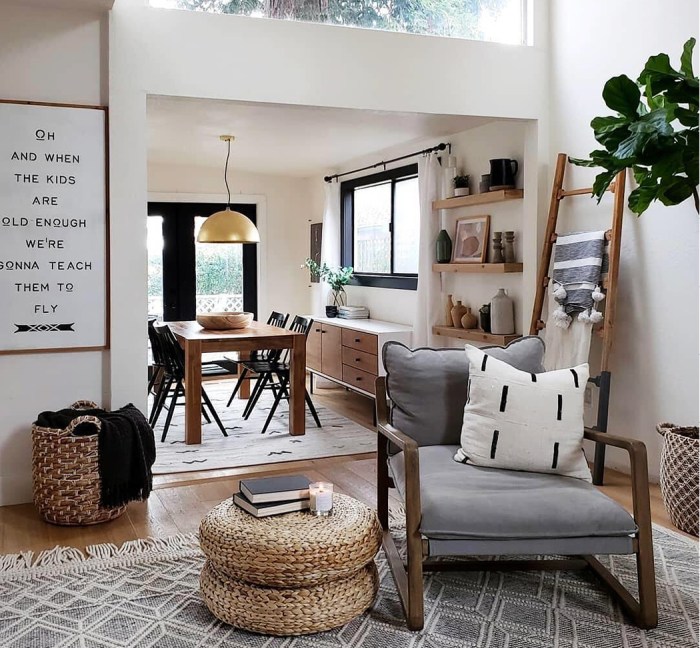Embark on a journey through the world of Scandinavian interior design, where elegance meets simplicity in a harmonious blend of form and function. This guide offers a comprehensive look at the key elements that define this timeless style, inviting you to explore the beauty of Nordic aesthetics.
Delve into the essence of Scandinavian design as we uncover its origins, color palettes, furniture choices, textures, lighting techniques, and practical approach to creating spaces that are both stylish and functional.
Introduction to Scandinavian Interior Design
Scandinavian interior design is a minimalist and functional approach to decorating spaces that originated in the Nordic countries of Denmark, Norway, Sweden, and Finland.
The key characteristics of Scandinavian interior design include simplicity, functionality, natural elements, light colors, clean lines, and a focus on creating a cozy and inviting atmosphere.
History and Origins
Scandinavian interior design emerged in the early 20th century as a response to the harsh winters and limited daylight in the Nordic region. Designers sought to create bright and airy spaces that would make the most of natural light and bring a sense of warmth and comfort to homes.
Color Palette in Scandinavian Interior Design

In Scandinavian interior design, the color palette is characterized by light, neutral tones that create a sense of brightness and airiness in the space. These colors are often inspired by the natural elements found in the Nordic region, such as the white of snow, the soft greys of rocks, and the pale blues of the sea and sky.
Importance of Light and Neutral Colors
Light and neutral colors play a crucial role in creating the signature Scandinavian look. They help to maximize natural light in the space, making rooms feel larger and more open. Additionally, these colors create a sense of calm and tranquility, promoting a cozy and inviting atmosphere that is essential in Scandinavian design.
- White: White is a staple color in Scandinavian interiors, symbolizing purity and simplicity. It is often used on walls, ceilings, and furniture to reflect light and create a bright, airy feel.
- Grey: Soft shades of grey are commonly used to add depth and warmth to a space without overpowering it. Grey tones can be found in furniture, textiles, and accent pieces in Scandinavian design.
- Beige: Beige hues bring a sense of warmth and comfort to a room, making it feel more inviting. Beige is often used in flooring, rugs, and upholstery to add a touch of coziness to the minimalist aesthetic.
- Pastels: Soft pastel colors like pale blue, blush pink, and mint green are occasionally used as accents in Scandinavian interiors to add a subtle pop of color and create a serene ambiance.
Elements of Furniture and Decor
In Scandinavian interior design, the furniture and decor play a crucial role in creating a clean, functional, and inviting space. Let's explore the common elements found in Scandinavian interiors and how they contribute to the overall aesthetic.
Common Furniture Pieces
- One of the most iconic pieces of furniture in Scandinavian design is the mid-century modern sofa with clean lines and minimalistic design.
- Scandinavian interiors often feature sleek, functional storage solutions like floating shelves, sideboards, and cabinets to keep the space clutter-free.
- Chairs and tables with tapered legs, organic shapes, and light-colored finishes are also popular choices in Scandinavian decor.
Minimalist Approach to Furniture Design
In Scandinavian style, less is more when it comes to furniture design. The minimalist approach focuses on simplicity, functionality, and clean lines. Furniture pieces are carefully selected to serve a purpose while maintaining a sense of openness and airiness in the space.
The emphasis on quality over quantity is evident in Scandinavian interiors, where each piece of furniture is thoughtfully chosen for its design and functionality.
Natural Materials in Decor
- Wood is a key element in Scandinavian interior design, often seen in furniture pieces like dining tables, chairs, and bed frames. Light oak, beech, and pine are popular choices for their natural beauty and warmth.
- Leather accents, such as a sleek leather sofa or chair, add a touch of luxury and sophistication to Scandinavian decor. The combination of leather and wood creates a harmonious balance of textures and materials.
Textures and Fabrics in Scandinavian Design
In Scandinavian interior design, textures and fabrics play a crucial role in creating a cozy and inviting atmosphere. The use of materials like wool, fur, and linen adds warmth and tactile appeal to the space, enhancing the overall aesthetic.
Layering Textures for a Harmonious Look
When it comes to incorporating textures in Scandinavian design, layering is key. By mixing different fabrics and materials, you can create depth and visual interest in the space. Here are some tips on how to layer textures effectively:
- Start with a base layer: Begin with a neutral base such as a wool rug or linen curtains to set the foundation for the room.
- Add soft accents: Incorporate touches of fur or faux fur throws and pillows to introduce a cozy element to the space.
- Mix and match materials: Experiment with different textures like chunky knit blankets, smooth leather furniture, and natural wood finishes to create a dynamic look.
- Consider contrast: Play with contrasting textures, such as pairing a sleek metal lamp with a plush velvet sofa, to add visual intrigue.
Lighting Techniques in Scandinavian Interiors
Natural light plays a crucial role in Scandinavian design, as it helps to create a bright and airy atmosphere that is characteristic of this style. The use of lighting fixtures such as pendant lights and floor lamps further enhances the functionality and aesthetic appeal of Scandinavian interiors.
By strategically placing these fixtures, it is possible to achieve a cozy ambiance that is both inviting and functional.
Importance of Natural Light
In Scandinavian design, natural light is highly valued for its ability to create a sense of spaciousness and warmth. Large windows are often featured in Scandinavian interiors to maximize the amount of natural light that enters the space. This not only reduces the need for artificial lighting during the day but also contributes to a sense of connection with the outdoors.
Lighting Fixtures
Pendant lights and floor lamps are commonly used in Scandinavian interiors to provide both ambient and task lighting. Pendant lights can be hung above dining tables or kitchen islands to create a focal point in the room, while floor lamps can be placed in reading nooks or living areas to add warmth and coziness.
Creating a Cozy Ambiance
To create a cozy ambiance through lighting in a Scandinavian interior, it is important to layer different sources of light. Combining overhead lighting with task lighting and accent lighting can help to create a multifunctional space that is both practical and inviting.
Soft, diffused lighting can also be used to create a warm and welcoming atmosphere, especially during the darker winter months.
Functional and Practical Design

Functionality is a key aspect of Scandinavian interior design, where every piece of furniture and decor serves a purpose beyond just aesthetics. The emphasis is on creating a space that is not only beautiful but also highly functional and practical for everyday living.
Storage Solutions in Scandinavian Design
In Scandinavian interiors, storage solutions are seamlessly integrated into the design to maintain the clean and clutter-free aesthetic. Some examples include:
- Multi-functional furniture pieces like ottomans with hidden storage compartments or bed frames with built-in drawers.
- Wall-mounted shelves and cabinets that maximize vertical space and provide storage without taking up floor space.
- Baskets and bins made from natural materials like rattan or woven fibers that add texture while concealing clutter.
Outcome Summary

In conclusion, Scandinavian interior design stands as a testament to the power of minimalism and functionality in creating inviting living spaces. By embracing the principles of simplicity, natural elements, and light, this design style offers a timeless appeal that resonates with modern sensibilities.
Dive into the world of Scandinavian design and transform your home into a sanctuary of elegance and comfort.
FAQ Summary
What defines Scandinavian interior design?
Scandinavian interior design is characterized by minimalism, functionality, simplicity, and a focus on creating bright, airy spaces.
How do colors contribute to Scandinavian design?
The typical color palette in Scandinavian interiors includes whites, grays, and muted tones that enhance the sense of light and space.
What are common furniture pieces in Scandinavian interiors?
Common furniture pieces include clean-lined sofas, wooden chairs, and sleek storage solutions that prioritize both form and function.
How important is natural light in Scandinavian design?
Natural light plays a crucial role in Scandinavian interiors, creating a sense of warmth and openness that defines the style.
What fabrics are commonly used in Scandinavian design?
Textures like wool, fur, and linen are popular choices in Scandinavian interiors, adding warmth and tactile appeal to the space.














